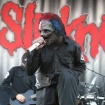It seems like you can't go to a metal, hardcore, or metalcore show these days without spilling your drink on her. Her hooded eyelids and high cheekbones are emblazoned on T-shirts, hoodies, and patches from Seattle to Oslo. She haunts bars, record stores, skate shops, and shopping malls. She is no one in particular, and yet people all over the world recognize her instantly. Like everyone else, we first saw her in 2001 on the cover of Jane Doe, the dizzying metallic hardcore classic from Massachusetts avant-dervishes Converge. Vocalist and lyricist Jake Bannon, who has created the overwhelming bulk of his band's vast visual output, gave birth to her in a fit of dejection. "The album's lyrical themes were born out of a dissolving relationship and the emotional fallout from that experience," he says. "Visually, I just wanted to capture that disillusionment with relationships and channel the negatives I felt. I did this in hopes of creating some sort of positive out of all the negative I was experiencing."

The result was a mystery lady created from a variety of media—collage, photography, spray paint, ink—that Bannon then assembled digitally. "When I work I usually start out with a sketch of some kind, either in my process book or on a scrap of paper," he explains. "I also did this with the Jane Doe album. By doing that, I work through ideas, write about them, and force them to evolve into something more refined. Process is extremely important for me—it allows me to have a log of my ideas, whether they're -successful or not. That said, I sketched the basic cover and started building it in layers, using acrylic, ink, and spray paint. Because of the -nature of the work and the need for flexibility in the imagery, I decided to build it in physical layers and scan certain elements for future use."
Abandoning several other ongoing art projects so he could work on Jane Doe exclusively for a month, Bannon applied the same meticulous process in creating all of the companion images that appear in the album's 28-page CD booklet. "Once I had the basic images completed, including the cover, I worked on type treatments for the release," he says. "At first I used old Letraset type but later switched to contemporary typography as the project progressed. My goal was to continue the kinetic feel of the imagery and make them one and the same."
Released on September 4, 2001—a week before the Twin Towers fell—Jane Doe had an immediate impact both sonically and visually. Since then, a number of bands and graphic designers have shamelessly bitten Bannon's style; a handful of clothing companies have actually appropriated the Jane Doe image without permission (all have been served with cease-and-desist letters) and a large counterfeit Jane Doe oil painting even surfaced in a Los Angeles punk-rock shop in late 2002 (it turned out to be an homage, not a rip-off). "Since the release of the album, there have been countless attempts at emulating that style of artwork," Bannon laments. "The attempts are both flattering and insulting. I feel that if you are putting that much effort into creating something to represent your band visually, you should do something original. Use your own artistic voice, not ours."
Since her debut, the woman known simply as "Jane" has become Converge's de facto icon, a hot-chick version of Iron Maiden's mascot, Eddie, or Motörhead's album-cover sentinel, Snaggletooth. "People relate music to a time and place that is meaningful to them, and I do the same," Bannon offers by way of indirect explanation. "I am flattered that my work and our collective album has been that for a variety of people. Or any of our albums, really."
According to her creator, no original version of the ubiquitous mystery lady exists. "I still rarely keep originals of anything," Bannon explains. "Not sure why, really—an emotional hangup, I guess. These days I'm trying to be better about keeping things."












